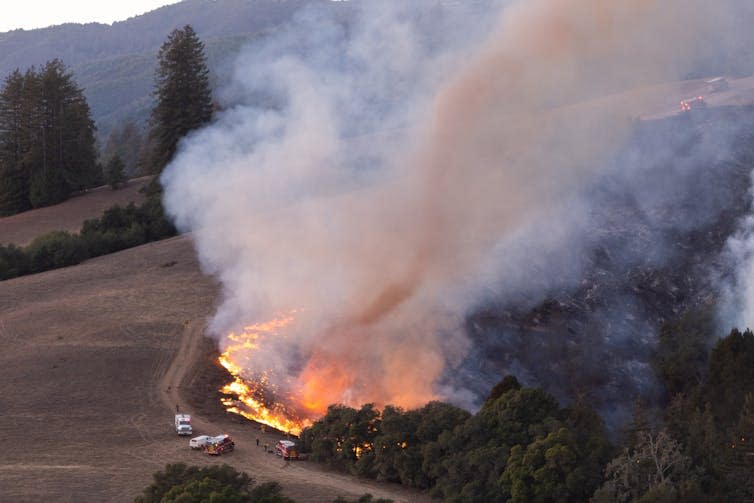After more than a year of record temperatures, the peak of the fire season is approaching across large parts of our green planet.
Many ecosystems have evolved to withstand regular fires, and some even thrive on them—there are plants that need flames to reproduce, for example. However, rising global temperatures have created entirely new fire regimes. This not only makes life more dangerous, it also exacerbates climate change.

This summary of The Conversation’s climate coverage is taken from our award-winning weekly climate action newsletter. Every Wednesday, The Conversation’s Environment Editor writes Imagine, a short email that digs a little deeper into just one climate issue. Join the 35,000+ subscribers.
“It feels like we’re getting used to the Earth being on fire,” say Víctor Fernández García and Cristina Santín, forest fire ecologists at the University of Lausanne and Swansea University, respectively. According to their new research, this is a relatively recent phenomenon: Extreme wildfires, the kind that killed more than 130 people in Chile in 2024, are twice as frequent and twice as destructive compared to two decades ago.
Read more: Extreme wildfires have doubled in just 20 years – here’s the science
Fossil fuel emissions have increased by more than a third over the same period. The burning of coal, oil and gas is the main reason the world is burning more often, more intensely and for longer. Climate change has made areas that are usually dry and prone to wildfires even drier and increased the likelihood of extreme heat waves. Animal agriculture and deforestation are also major causes.
But as we shall see, our rapidly warming climate is creating fires that are, in effect, laws unto themselves.
Fire begets fire
“When fires get big enough and hot enough, they can actually create their own weather,” said Kyle Hilburn, an atmospheric scientist at Colorado State University.
Scientists didn’t discover that fires could trigger thunderstorms until the late 1990s, Hilburn says. His research, using a fleet of satellites launched in 2017, has revealed that the “pyrocumulus” clouds that trigger these storms are actually common.
Read more: Wildfires can create their own weather, including tornado-like fire whirls — an atmospheric scientist explains how
Burning vegetation generates heat that warms the air near the ground. This air rises, leaving a void that is filled with cold air. As warm air continues to rise, it eventually condenses into clouds and some of it freezes. Liquid and frozen particles collide, generating a charge that is neutralized by lightning.
The parched atmosphere above a wildfire may not produce rain, but the “dry lightning” it does produce will seed new fires in dry grass and brush. The air rising from a wildfire is also whipped up by winds that can create “fire whirls” — flaming tornado-like swirls that scatter hot ash and spread the fire further.


Fires cause more fires because of their impact on local climate. The same is true on a global scale: when forests burn, they release the carbon they stored as they grew. More carbon in the air means more climate change; more climate change means more fires and more carbon in the air.
Russia reports a 50 percent increase in the size of its wildfires this summer as massive blazes billow smoke into the Arctic Circle. The far north of Europe, Asia and North America is enveloped by the boreal forest, one of the Earth’s largest carbon sinks.
“Over the past few thousand years, it has taken about 1 trillion tons of carbon from the air and stored it in the trees and soil,” say Natascha Kljun and Julia Kelly, environmental scientists at Lund University.
Kljun and Kelly argue that computer simulations of the Earth’s climate may underestimate the contribution of these wildfires to global warming. According to their study of the Swedish boreal forest, CO₂ emissions from burned areas continue for several years after the flames have died down.
Read more: Forests devastated by wildfires continue to emit carbon long after flames are extinguished – new study
Holding your breath
Even with a warming atmosphere that turns forests into tinderboxes, many wildfires would not start if humans did not start them. Some of these are a matter of negligence, such as sparks from old power lines.
In South Africa, negligent landowners who fail to install fire barriers can be prosecuted for allowing fires to spread unchecked. Tracy-Lynn Field, professor of environmental law at the University of the Witwatersrand, believes this could become a powerful tool to limit the number of fires that spread.
Read more: South Africa’s wildfires set to increase: How legal action could help the country better adapt to climate change
Stricter regulations may be needed in fire zones across Western Canada, and not just for environmental reasons.
“Over the past two decades, emissions from most pollution sources have declined [have] “As exposure to wildfire smoke has decreased, Canadians’ exposure to wildfire smoke has increased by about 220%,” said health scientists Stephanie Cleland and Ryan W. Allen of Simon Fraser University.


Health experts once studied the sporadic effects of wildfire smoke—how a few days of exposure can worsen asthma, for example. Now, as communities breathe in smog for months on end, researchers are bracing for grimmer outcomes: reduced lung function, increased risk of dementia and premature death.
Read more: As wildfires become more frequent and intense, what are the long-term health effects of prolonged smoke exposure?
Long-term exposure to wildfire smoke is a growing public health problem in many places. But it’s not just us who are having trouble breathing.
“[Plants] react a little like us [to wildfires]“It turns out,” say Delphine Farmer and Mj Riches, experts in chemistry and botany at Colorado State University.
“Some trees essentially close their windows and doors and hold their breath.”
Read more: Trees don’t like breathing in smoke from wildfires either – and they hold their breath to avoid it
Farmer and Riches accidentally discovered that ponderosa pines in Colorado closed leaf-bound pores called stomata in response to wildfire smoke. The trees effectively stopped breathing, halting the photosynthesis that keeps them alive.
The long-term effects of smoky air in forests are still unclear. But as with human exposure, the prognosis could be very bad indeed.
This article is republished from The Conversation under a Creative Commons license. Read the original article.